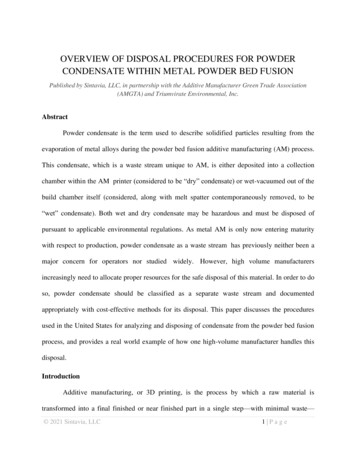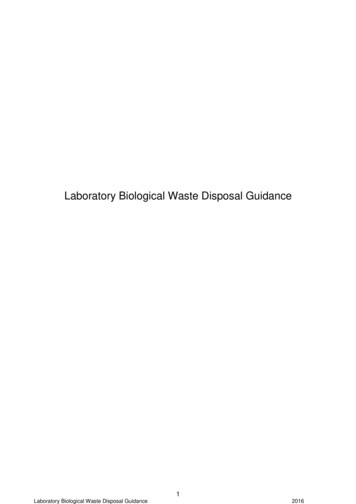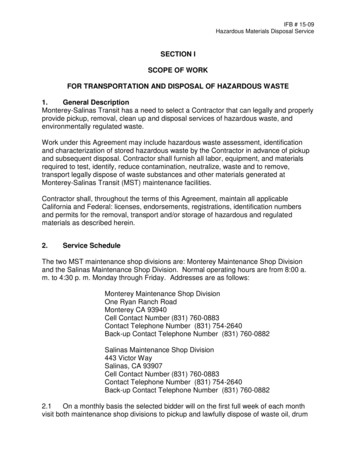
Transcription
OVERVIEW OF DISPOSAL PROCEDURES FOR POWDERCONDENSATE WITHIN METAL POWDER BED FUSIONPublished by Sintavia, LLC, in partnership with the Additive Manufacturer Green Trade Association(AMGTA) and Triumvirate Environmental, Inc.AbstractPowder condensate is the term used to describe solidified particles resulting from theevaporation of metal alloys during the powder bed fusion additive manufacturing (AM) process.This condensate, which is a waste stream unique to AM, is either deposited into a collectionchamber within the AM printer (considered to be “dry” condensate) or wet-vacuumed out of thebuild chamber itself (considered, along with melt spatter contemporaneously removed, to be“wet” condensate). Both wet and dry condensate may be hazardous and must be disposed ofpursuant to applicable environmental regulations. As metal AM is only now entering maturitywith respect to production, powder condensate as a waste stream has previously neither been amajor concern for operators nor studied widely. However, high volume manufacturersincreasingly need to allocate proper resources for the safe disposal of this material. In order to doso, powder condensate should be classified as a separate waste stream and documentedappropriately with cost-effective methods for its disposal. This paper discusses the proceduresused in the United States for analyzing and disposing of condensate from the powder bed fusionprocess, and provides a real world example of how one high-volume manufacturer handles thisdisposal.IntroductionAdditive manufacturing, or 3D printing, is the process by which a raw material istransformed into a final finished or near finished part in a single step—with minimal waste— 2021 Sintavia, LLC1 Page
through the gradual addition of incremental layers of material. One of the most commerciallysuccessful methods of additive manufacturing is called metal powder bed fusion (PBF). PBFconsists of a raw material, in this case virgin metal powder, which is loaded into a build chamberand melted by an energy source in consecutive layers. After a single layer is melted, the buildplate descends by a designated height, followed by a re-coater arm programmed to sweep thenext layer of powder over the prior layer. The process is then repeated until the part is completedand removed from the build chamber. Following its removal, the part undergoes additional stepsincluding furnacing, machining, inspections, etc., until it is shipped to the customer.The market size for additive manufacturing is growing rapidly and is expected to increasesignificantly in the coming years, with the PBF process projected to be a major driver of thisgrowth. According to Grand View Research, “[the metal PBF] market size was valued at USD772.1 million in 2019 and is expected to grow at a compound annual growth rate of 27.8% from2020 to 2027.” Major industries adopting PBF include automotive, aerospace, and healthcareindustries, as PBF offers lower costs and weight reduction compared totraditionalmanufacturing, as well as allowing companies to produce more intricate and efficient designs.As a new manufacturing technology, PBF unsurprisingly produces new waste streams,some of which may be hazardous. While AM waste streams typically represent a fraction of thewaste produced in traditional manufacturing methods, they nonetheless represent a unique wastedisposal challenge. As a result, diligent care must be taken by manufacturers to transport anddispose of these waste streams.Background: United States EPA Regulations for the Generation, Transport, and Disposalof Hazardous WasteHazardous waste is defined as any solid or liquid waste that may exhibit certain 2021 Sintavia, LLC2 Page
characteristics as defined by the U.S. Environmental Protection Agency (EPA). The EPAregulates hazardous waste under the Resource Conservation and Recovery Act (RCRA) to ensureit is safely being managed to protect the environment and human health. The RCRA addressesthe generation, transportation, treatment, storage, and disposal of all hazardous wastes under themethod known as “cradle-to-grave,” illustrated in Figure 1 below. Importantly, additivemanufacturers, as with all manufacturers, are responsible for full life cycle disposal of theirwaste streams and must be fully aware of where (and by whom and treatment method) theirhazardous waste is being permanently disposed.Figure 1: Cradle-to-Grave SystemGenerally speaking, there are two main types of “industrial” waste: hazardous waste andregulated non-hazardous waste. Hazardous waste may be deemed as such due to ignitable,corrosive, reactive, radioactive, or toxic characteristics. Depending on the relevant classification,hazardous waste is assigned a “D” waste code (or F, K, P, and U in lesser cases) established bythe EPA and shown in Figure 2 below. Once assigned a code, it must be controlled andtransported in connection with U.S. Department of Transportation (USDOT) and RCRA 2021 Sintavia, LLC3 Page
guidelines. Regulated non-hazardous waste pertains to any substance that is concluded to be nonhazardous by certified lab technicians through testing and approved to be disposed of at alandfill.Figure 2: Hazardous Waste D CodesFor hazardous waste generators, EPA requirements include: (i) waste permits and anassigned EPA ID for the storage and handling of hazardous waste, (ii) written manifests for thehazardous material, (iii) quantity and proper record keeping of its generation, and (iv) anemergency action plan (EAP) for the company (including proper training).For hazardous waste transportation (by ground, train, air, or water), it is critical that thehazardous waste is stabilized and contained for the entire length of transit. Also required is anEPA ID, to comply with the EPA’s hazardous waste manifest system, and to obey all USDOTregulations. At the end location facilities, hazardous waste can be treated on site, stabilized andfully disposed of, or incinerated. A certificate of destruction can be made available and presentedto the waste transporter as well as the hazardous waste generator.For hazardous waste land disposal, according to the Hazardous and Solid Waste 2021 Sintavia, LLC4 Page
Amendments to RCRA (HSWA), it is prohibited to dispose of untreated hazardous waste in alandfill. Certain concentration levels and methods of previous treatment is required by the EPAbefore land disposal to prevent health hazards. Alternatives to disposal are recycling solutionssuch as metal recovery or multipurpose energy sources. However, recyclability depends on thequality and ease of material recovery for reuse or resale and recycler certifications on whatmaterial properties and quantity are permitted.PBF Raw Material: Powdered Metal AlloysFigure 3: Powdered Metal at Microscopic LevelThe raw material in the PBF process is processed metal powder. Common metalpowders in production applications include nickel, steel, titanium, and aluminum alloys. Someof these alloys, such as nickel (Inconel 718 and Inconel 625) and steel (316L and 17-4PH),contain chromium, which is on the EPA’s list of top 30 urban air toxic pollutants. Chromiumcontent in condensate generated from these alloys often exceeds the EPA’s allowance of 5 mg/L,and therefore must be treated as hazardous for toxicity. These alloys may also contain traceamounts of lead, although below the EPA’s 5 mg/L limit.While titanium and aluminum alloys do not have the same hazardous 2021 Sintavia, LLC5 Pagewaste
considerations specifically relating to chromium, both titanium and aluminum waste powder areconsidered reactive metals and may be ignitable (other metal condensate, including non-reactivemetals, remain at risk for ignitability as well, due to particle size and morphology). It is of highimportance that metal condensate from these alloys is kept inert per manufacturer and wastedisposal company guidelines to avoid combustion in transport. The EPA utilizes threealternating test methods for ignitability. Wastes that are considered hazardous due to ignitabilityinclude “liquids with flash points below 60 C, non-liquids that cause fire through specificconditions, ignitable compressed gases and oxidizers.” According to the ignitability of solidstest method SW-846 Test Method 1030, “Wastes that have a rate of burning of more than 2.2mm/sec (or burn time of less than 45 sec for 100 mm) are considered to have a positive result forignitability according to USDOT regulations. For metals, this time is 10 minutes or less for 100mm (or a burn rate of more than 0.17 mm/sec).”Condensate DesignationCondensate is described as a vapor plume resulting from evaporation of a metal alloyduring the AM PBF process1. The vapor is subjected to continuous gas flow within the buildchamber which can rapidly solidify the condensate into particles. These condensate particles aremade up of numerous metals, usually with hazardous and combustible elements. Dry condensateis carried away using the machine’s inert gas flow, through a filter system, then deposited into abin for removal. Wet condensate, which includes spatter, is suctioned out of the build chamberitself using a water based wet separator vacuum.1Most PBF machines use lasers as energy sources, which operate in an inert build environment, as opposed to electronbeam printers, which operate in a vacuum. In spite of this, electron beam printers have their own version of what couldbe considered dry condensate in the form of metallization sheaves that attach to the electron beam machine’s heatshield, as well as wet condensate in the form of spatter that must be wet-vacuumed out (similar to laser machines). 2021 Sintavia, LLC6 Page
Figure 4: Condensate GenerationOnce collected, dry condensate runs the risk of combustion (particularly titanium andaluminum powder waste), and proper passivation is vital before transport per EPA requirements.Silicone oil is a preferred material since it has a higher flash point threshold compared to mineraloil. Flocculants such as chalk or sand are also recommended by the manufacturer to encapsulatethe condensate and prevent possibility of oxidation that may lead to combustion.Lab Sampling Procedures and TestingOnce waste condensate has been generated by an additive manufacturer, it must beanalyzed by an accredited third-party lab to determine chemical composition and potentialhazardous components. Every U.S. state has individual requirements for its testing facilities.They must be substantiated by local departments of health to obtain permits, certifications, andaccreditations. The waste generator, lab technicians, and waste disposal company work jointly toform a waste profile describing the components of each waste stream. An accurate waste profileis required by the EPA and USDOT before transportation. These samples can either becomposite samples (multiple samples taken at regular intervals over a period) or a grab sample 2021 Sintavia, LLC7 Page
(one time sample taken at singular point for collection) and should be stored in a preserved orunpreserved container. Preserved containers are preferred for materials or chemicals that mayevaporate or have a reaction with oxygen such as the condensate.Routine chemical analysis tests like toxicity characteristic leaching procedure are used todetermine whether there are hazardous elements present in the waste sample. The test entails aleaching simulation and reveals any negative health hazard results. Other instruments used fortesting include gas chromatography, mass spectrometry, inductively coupled plasma, x- rayfluorescence, optical emissions spectroscopy, and a mercury analyzer.A separate test is required to determine ignitability, based temperature conditions andburn rates.As discussed, some metal powders such as, but not limited to, aluminum andtitanium may “flash” when subjected to high temperatures during analysis. If a substanceflashes, it must be disposed at an official incineration facility. Depending on the hazardousmaterial concentration in the full chemical analysis, the material may have to be neutralized byan inert agent before transportation.Disposal is based on all the information discussed above. Once all factors are on for landfill, or incineration. Often times, a sample will need to be shippedfor benchmark testing at the end disposal site before final approval. 2021 Sintavia, LLC8 Page
Figure 5: Analytical Instruments for Hazardous Waste Lab TestingCase Study: Sintavia, LLCBased in Hollywood, Florida, Sintavia, LLC designs and prints (via the PBF process)complex, mostly thermodynamic components for the Aerospace, Defense, and Space industry.They were the firstindependent manufacturer of their kind to offer a vertically integrated, end-toend metal additive design and manufacturing production process that met aerospace productionquality standards with respect to these parts. The company is Nadcap and ISO/IEC 17025accredited, AS9100/9110 certified, and ISO 14001 certified. Currently, Sintavia utilizes 28 PBFprinters and plans to add two to three more in 2021, and eight to ten again in 2022. They have astate-of-the-art quality and metrology department as well as a full-scale machine shop for postprocessing. The majority of the company’s printers are from EOS GmbH. 2021 Sintavia, LLC9 Page
Currently at Sintavia, condensate is handled and disposed of per standards set forth by theEPA, Florida Department of Environmental Protection (FDEP), and Florida Department ofTransportation (FDOT). These standards are adhered to at the highest level when working withcondensate. While using a wet separator vacuum, condensate is recommended to be neutralizedby water or oil with organic additives. For dry condensate within the machine, argon gas isutilized to prevent any oxidation/reaction of the powder during exposure. From the printer, drycondensate is then transferred into an airtight particle bin promptly filled with sand and siliconeoil as the neutralizing agents.Figure 6: EOS AM Machines at SintaviaWith respect to the analysis of condensate, Sintavia uses internal and external labresources to perform any necessary testing. Following respective sampling procedures, possibleanalytical could include TCLP, mercury analysis, and ignitability. 2021 Sintavia, LLC10 P a g e
Figure 7: In House Laboratory at SintaviaTransportation and disposal of hazardous materials are regulated monthly between theenvironmental, health, and safety engineer and Triumvirate Environmental, Sintavia’s hazardouswaste removal partner. Regardless of waste stream, however, Sintavia is aware of—and remainsliable for—the appropriate disposal of each type of condensate.According to Ashley Wallace, Sintavia’s Quality & EHS Engineer, knowing where eachcondensate stream is going is just as important as the careful preparation of each type of waste.“As we have grown, we have recognized that proper disposal of all of our waste streams must bea priority. We have worked with Triumvirate Environmental and other experts within theindustry to manage the final disposal of these streams according to all regulatory requirements.”The ultimate goal is to find beneficial reuse or recycling options, which will continue to becomemore available as technology advances. The company’s main waste streams are disposed of inthe following manner: Aluminum alloy condensate is considered ignitable, and is therefore deemed hazardous 2021 Sintavia, LLC11 P a g e
waste. It is sent to an incineration plant in Ohio. Nickel and stainless-steel alloy condensate contains chromium content above the EPA’s5ppm limit; therefore, it is categorized as hazardous waste. This material is recyclableand current strategies, such as metal recovery, are under development. For now, thiswaste is solidified and disposed of in an underground facility in Canada. Titanium alloy condensate is non-ignitable with no chromium content; therefore, it isclassified as regulated, non-hazardous waste. This material is recyclable and currentstrategies, such as metal recovery, are under development. For now, this waste istransported to a waste energy facility in Georgia. Wet condensate from the wet-vacuum is considered hazardous due to chromiumcontentabove 5 ppm. It is solidified and disposed of at an approved landfill in Kentucky. Industrial wastewater is considered non-hazardous. It is sent to a wastewater treatmentfacility in South Florida.These waste streams are disposed of in conjunction with manufacturer guidelines anddisposal company recommendations.SummaryAs PBF manufacturing and the AM industry continue to grow and expand, so will theimportance of disposing of condensate waste in a safe and efficient manner. While wastestreams generated by PBF represent a small fraction when compared to similar traditionalmanufacturing processes, correct disposal of condensate remains a critical aspect of theunderlying environmental benefits of PBF. In addition, research is currently being performed onrecycling alternatives for metal condensate, which would assist in reducing this waste. For now, 2021 Sintavia, LLC12 P a g e
however, respectable disposal of condensate waste remains a priority for the growing industry.Awareness of and compliance with the EPA’s regulations are essential for the long-term successof the PBF AM industry.Resources1) “EPA Hazardous Waste Codes.” UMD, 9 Oct. 2017, essr.umd.edu/epa-hazardous-wastecodes.2) “Hazardous Waste.” EPA, Environmental Protection Agency, 8 Dec. 2020,www.epa.gov/hw.3) “Hazardous Waste Permitting.” EPA, Environmental Protection Agency, 8 Dec. 2020,www.epa.gov/hwpermitting.4) “Hazardous Waste Transportation.” EPA, Environmental Protection Agency, 13 May2020, irements.5) “Defining Hazardous Waste: Listed, Characteristic and Mixed Radiological Wastes.”EPA, Environmental Protection Agency, 16 July 2020, acteristic-and-mixed-radiological-wastes#ignite.6) EPA, Environmental Protection Agency, www.epa.gov/node/127431 .7) “Hazardous Waste Generator Regulatory Summary.” EPA, Environmental ProtectionAgency, 7 Feb. 2019, -regulatorysummary.8) “3D Printing Metal Market Size, Share: Industry Report, 2020-2027.” 3D Printing MetalMarket Size, Share Industry Report, 2020-2027, l-printing-market. 2021 Sintavia, LLC13 P a g e
9) “Urban Air Toxic Pollutants.” EPA, Environmental Protection Agency, 9 Feb. pollutants.10) A GE Additive company, AP&C. Aluminum Powders for Additive ges/AP%26C Aluminum White%20paper v1.pdf.11) Saunders, Marc. “Spatter Matters!” LinkedIn, s/.12) Saunders, Marc. “AM's Dirty Little Secret.” AM's Dirty Little ret-marc-saunders/.13) Saunders, Marc. “To Infinite Powder Reuse - and Beyond!” use-beyond-marc-saunders/.14) “Powders.” GE Additive Powders, www.ge.com/additive/powders-overview.15) Metal Powders for Additive Manufacturing, al-powders-for-additive-manufacturing.html.16) “3D Printing Metal Market Size, Share: Industry Report, 2020-2027.” 3D Printing MetalMarket Size, Share Industry Report, 2020-2027, l-printing-market.17) Multidisciplinary Digital Publishing Institute. Material Reuse in Laser Powder BedFusion. 2020, www.mdpi.com/2075-4701/10/3/341/pdf. 2021 Sintavia, LLC14 P a g e
waste produced in traditional manufacturing methods, they nonetheless represent a unique waste disposal challenge. As a result, diligent care must be taken by manufacturers to transport and dispose of these waste streams. Background: United States EPA Regulations for the Generation, Transport, and Disposal of Hazardous Waste










